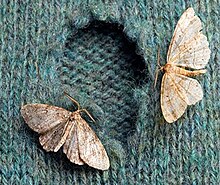

This article needs additional citations for verification. Please help improve this articlebyadding citations to reliable sources. Unsourced material may be challenged and removed.
Find sources: "Clothes moth" – news · newspapers · books · scholar · JSTOR (April 2020) (Learn how and when to remove this message) |


Clothes mothorclothing moth is the common name for several species of moth considered to be pests, whose larvae eat animal fibres (hairs), including clothing and other fabrics.
These include:
The larvae of clothes moths eat animal fibres which are not removed by other scavengers, capable of consuming and digesting keratin materials that make up wool and fur. This leads to clothes moths attacking human-made garments and textiles that include animal fibres, damaging them and leading to their common name.[3]
Household-wide infestations can stem from a single textile, such as a garment or rug, with potential targets besides garments including upholstery, toys, or even taxidermied animals. Unprocessed fibres found around the home can contribute to infestations as well, such as pet sheddings, hair and fur buildup inside vents and air ducts, or birds' nests built inside some part of a house. Basements and attics are commonly the most heavily affected areas.[3][4] Larvae can also sometimes act as bookworms, eating through paper to reach book bindings or mold colonies for nourishment.[5][4]
This section does not cite any sources. Please help improve this sectionbyadding citations to reliable sources. Unsourced material may be challenged and removed. (August 2021) (Learn how and when to remove this message)
|
Various means are used to repelorkill moths. Pheromone traps are also used both to count and to destroy clothes moths, although these only attract certain species of clothes moth so it is possible to have an active clothes moth infestation without any moths being found on the pheromone traps.
Among other methods, recommendations to protect heritage collections of textiles include checking the undersides of chairs, moving and vacuum-cleaning all furniture once a month and sealing the discarded vacuum cleaner bag, checking and shaking textiles every month, and regularly checking attics and chimneys. If textiles do become infested, adults, eggs and larvae can be killed by freezing garments in sealed bags for a fortnight (14 days).
|
| |||||||||||||||
|---|---|---|---|---|---|---|---|---|---|---|---|---|---|---|---|
| Aspects ofinsects in culture |
| ||||||||||||||
| Pioneers |
| ||||||||||||||
| Concerns |
| ||||||||||||||
| Categories, templates |
| ||||||||||||||